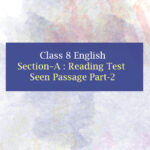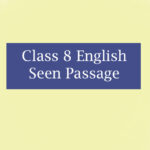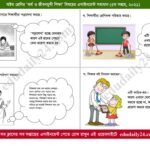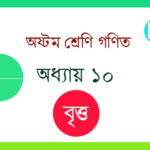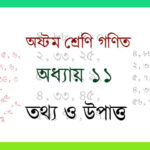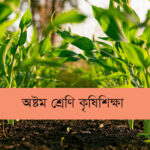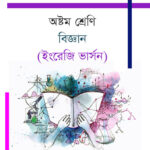Class 8 English 1st Paper : Reading Test : Seen Passage (Part-1)
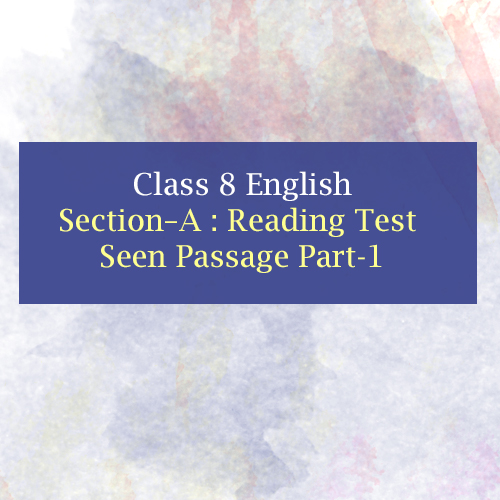
Read the text and answer the questions 1, 2 and 3. (Unit–1, Lesson–02)
Nakshi Kantha is a kind of embroidered quilt. The name was taken from the Bengali word, ‘naksha’ which means artistic pattern. It is a kind of traditional craft and is said to be indigenous to Bangladesh and West Bengal in India. The art has been practised in rural Bengal for centuries. The name ‘Nakshi Kantha’ became popular after the poet Jasimuddin’s poem ‘Nakshi Kanthar Math’ was published in 1929.
Traditional kanthas are made for family use. Old or new cloth and thread are used to make these quilts. Mymensingh, Jamalpur, Rajshahi, Faridpur, Bogra and Jessore are most famous for this craft. Now it is produced commercially. You can find them in many expensive handicraft shops in cities. The quilts are now in great demand because of the colourful patterns and designs embroidered on them.
Set 1
- Guess the meaning of the following words and choose the correct meaning closest to the text :
- i) Kind :
- i) sympathetic ii) sort ii) sympathy iv) benevolent
- ii) Pattern :
- i) decoration ii) design iii) mark iv) embellishment
iii) Indigenous :
- i) indigestion ii) native iii) indigestible iv) indignant
- iv) Traditional :
- i) rule ii) conventional iv) conventional iv) convention
- iv) Thread :
- i) yarn ii) threat iii) yard iv) rield
- Answer the following questions :
(a) What is Nakshi Kantha?
(b) How long has the art been practised?
(c) Which areas are most famous for this craft?
(d) Why are the traditional Kanthas made?
(e) Why are the quilts now in great demand?
- Summarize the passage in around 50/85 words.
Answer
- (i) (d) benevolent; (ii) (b) design; (iii) (b) native; (iv) (c) conventional; (v) 9a) yarn.
- (a) Nakshi Kantha is one kind of embroidered quilt.
(b) The art has been practised for centuries.
(c) Mymensingh, Jamalpur, Rajshahi, Faridpur, Bogra and Jessore and most famous for this craft.
(d) The traditional Kanthas are made for family use.
(e) The quilts are now in great demand for the colourful patterns and designs.
- Nakshi Kantha is a traditional embroidered quit. The name was taken from the Bengali word ‘naksha’ which means artistic pattern. The art of Nakshi kantha has been practiced in rural areas of Bangladesh and West Bengal in India for centuries. Mymensingh, Jamalpur, Rajshahi, Faridpur, Bogra and Jessore are famous for ‘Nakshi kantha’. It became popular after the poet Jasimuddin’s poem ‘Nakshi Kanthar Math’ was published in 1929. People like it for its colourful patterns and designs embroidered on it.Now it is in great demand and produced commercially.
Set 2
- Choose the best answer from the alternatives :
- a) The word ‘Nakshi Kantha’ comes from the ¾¾
- i) English ii) Bengali iii) Hindi iv) Burmese
- b) Nakshi Kantha is a ¾¾
- i) modern ii) ultramodern iii) age old iv) conventional
- c) ‘Nakshi Kantha’ is related with ¾¾.
- i) urban people ii) rural people ii) ethnic people iv) tribal people
- d) Nowadays Nakshi Kantha is produced ¾¾.
- i) traditionally ii) nationally iii) commercially iv) normally
- e) ‘Nakshi Kanthar Math’ is written by ¾¾.
- i) Kazi Nazrul Islam ii) Farrukh Ahmed iii) Jasimuddin iv) Rabindranath Tagore
- Give short answer the following questions :
(a) What is ‘Nakshi Kantha’?
(b) How long has this been practised?
(c) What kind of craft is it?
(d) What districts are famous for “Nakshi Kantha’?
(e) Why are ‘Nakshi Kanthas’ now in great demand?
- Summarize the passage in around 50/85 words.
Answer
- (a) (ii) Bengali; (b) (iv) conventional; (c) (ii) rural people; (d) (iii) commercially; (e) (iii) Jasimuddin.
- (a) Nakshi Kantha is a kind of embroided quilt.
(b) The art has been practised for centuries.
(c) It is a kind of traditional craft.
(d) Mymensingh, Jamalpur, Rajshahi, Faridpur, Bogra and Jessore are famous for ‘Nakshi kantha’.
(e) ‘Nakshi kanthas’ are now in great demand for the colourful patterns and designs.
- Same as Set 1
Set 3
- Choose the best answer from the alternative :
- a) The term ‘indigenous’ means–
- i) indigestible ii) native iii) famous iv) wild
- b) Nakshi Kanthas are a kind of–
- i) quilt ii) song iii) embrodiered quilt iv) crop
- c) Jasimuddin was a famous–
- i) poet ii) scientist ii) painter iii) architect
- d) The art of Nakshi Kanthas is most famous to ¾¾ districts in Bangladesh.
- i) three ii) four iii) five iv) six
- e) The people of Bangladesh and West Bengal usually prepare kanthas for ¾¾
- i) national ii) industrial iii) family iv) commercial
- Write short answer the following questions :
(a) What does ‘naksha’ mean?
(b) Where has the art of ‘Nakshi Kantha’ been practised for ages?
(c) What materials are required to prepare Nakshi Kanthas?
(d) When did the name ‘Nakshi Kantha’ become popular?
(e) Why are ‘Nakshi Kanthas’ in great demands?
- Summarize the passage in around 50/85 words.
Answer
- (a) (iii) native; (b) (iii) embroidered quilt; (c) (i) poet; (d) (iv) six; (e) (iii) family.
- (a) ‘Nakasha’ means artistic pattern.
(b) The art of ‘Nakshi Kantha’ has been practised in rural Bengal for ages.
(c) Old or new cloth and thread are required to prepare Nakshi kanthas.
(d) The name ‘Nakshi Kantha’ became popular after the poet Jasimuddin’s poem ‘Nakshi Kanthar Math was published in 1929.
(e) The ‘Nakshi Kanthas’ are in great demand for the colourful patterns and design.
- Same as Set 1
Set 4
- Choose the best answer from the alternatives :
- a) ¾¾ are most famous for the craft.
- i) Mymensingh, Dhaka ii) Rajshahi, Rangpur
iii) Mymensingh, Jessore iv) Bogra, Pabna
- b) Nakshi Kanthas are a kind of–
- i) cloth ii) quilt iii) embroidered quilt iv) Shitol Pati
- c) What does the word ‘pattern’ mean?
- i) step by step ii) series iii) artistic design iv) handmade work
- d) What are used to make these quilt?
- i) New cloth ii) Old cloth
iii) Polymer thread iv) Any type of cloth and thread
- e) Where has the art been practised?
- i) Large cities ii) Urban area iii) Rural area iv) Rich family
- Give short answer the following questions :
(a) What does “naksha” mean?
(b) How did it become famous?
(c) Do you like a Nakshi Kantha or an ordinary kantha? Why?
(d) Why are they in great demand?
(e) In cities, where do we get them?
- Summarize the passage in around 50/85 words.
Answer
- (a) (iii) Mymensingh, Jessore; (b) (iii) embroidered quilt; (c) (iii) artistic design; (d) (iv) Any type of cloth and thread; (e) (iii) Rural area.
- (a) “Naksha” means artistic pattern.
(b) Poet Jasimuddin’s poem “Nakshi Kanthar Math” made it famous.
(c) I like Nakshi Kantha for its colourful patterns and designs.
(d) They are in great demand for the colourful patterns and designs.
(e) We get them in many expensive handicraft shops in cities.
- Same as Set 1
Set 5
- Guess the meaning of the following words. Choose the correct meaning closest to the text.
(a) kind
- sympathetic ii. sort iii. sympathy iv. benevolent
(b) pattern
- decoration ii. design iii. mark iv. embellishment
(c) indigenous
- indigestion ii. native iii. indigestible iv. indignant
(d) thread
- yarn ii. threat iii. yard iv. field
(e) traditional
- rule ii. custom iii. conventional iv. convention
- Answer the following questions.
(a) What is Nakshi kantha?
(b) Nakshi kantha is a traditional craft of Bangladesh and India. How?
(c) Where has the art been practised?
(d) What are the traditional kanthas made?
(e) Describe its commercial value.
- Summarize the passage in around 50/85 words.
Answer
- (a) (ii) sort; (b) (ii) design; (c) (ii) native; (d) (i) yarn; (e) (iii) conventional.
- (a) Nakshi Kantha is a kind of embroidered quilt.
(b) Yes, it is. The art of Nakshi kantha has been practiced in rural areas of Bangladesh and West Bengal in India for centuries.
(c) The art has been practiced in rural Bengal.
(d) The traditional kanthas are made for family use.
(e) Nakshi kantha is produced commercially because we can find them in many expensive handicraft shops in cities.
- Same as Set 1
Class 8 English 1st Paper : Reading Test : Seen Passage (Part-1)
Set 6
- Guess the meaning of the following words and choose the correct meaning.
(a) kind
- sympathetic ii. sort iii. sympathy iv. benevolent
(b) indigenous
- indigestion ii. native iii. indigestible iv. indignant
(c) traditional
- rule ii. custom iii. conventional iv. convention
(d) thread
- yarn ii. threat iii. yard iv. field
(e) famous
- renowned ii. notorious iii. famine iv. fume
- Answer the following questions.
(a) What is Nakshi kantha?
(b) How long has the ar been practised?
(c) Why was the name popular?
(d) Why are traditional kanthas made?
(e) Why are the quilts now in great demand?
- Summarize the passage in around 50/85 words.
Answer
- (a) (ii) sort; (b) (ii) native; (c) (iii) conventional; (d) (i) yarn; (e) (i) renowned.
- (a) Nakshi Kantha is a kind of embroidered quilt.
(b) The art has been practised for centuries.
(c) The name was popular because it is related to poet Jasimuddin’s poem “Nakshi Kanthar Math”.
(d) The traditional kanthas are made for family use.
(e) The quilts are now in great demand for its colourful patterns and designs embroidered on them.
- Same as Set 1
Set 7
- Guess the meaning of the following words. Choose the correct meaning closest to the text.
(a) embroidered
- embellished ii. patterned iii. coloured iv. decoration
(b) traditional
- unusual ii. modern iii. innovative iv. conventional
(c) pattern
- figure ii. plan iii. design iv. motif
(d) indigenous
- indigestion ii. native iii. indigestible iv. indignant
(e) famous
- fame ii. known iii. well-known iv. extraordinary
- Answer the following questions.
(a) What is ‘Nakshi kantha’?
(b) How is it made?
(c) Why are the quilts now in great demand?
(d) How long has this been practised?
(e) Why are the traditional kanthas made?
- Summarize the passage in around 50/85 words.
Answer
- (a) (i) embellished; (b) (iv) conventional; (c) (iii) design; (d) (ii) native; (e) (iii) well-known.
- (a) Nakshi kantha is a kind of embroidered quilt.
(b) Old or new cloth and thread are used to make this quilt.
(c) The quilts are now in great demand for their colourful patterns and designs embroidered on them.
(d) This art has been practised for centuries.
(e) The traditional kanthas are made for family use.
- Same as Set 1
Class 8 English 1st Paper : Reading Test : Seen Passage (Part-1)
Set 8
- Guess the meaning of the following words and choose the correct meaning closest to the text.
(a) pattern
- design ii. cloth iii. picture iv. portrait
(b) craft
- a device ii. asset iii. art iv. property
(c) indigenous
- familiar ii. foreign iii. native iv. artificial
(d) expensive
- costly ii. cheap iii. different iv. excellent
(e) demand
- price ii. need iii. popularity iv. familiarity
- Answer the following questions.
(a) What is ‘Nakshi kantha’?
(b) From when has the art of Nakshi kantha been practised?
(c) How did the name Nakshi kantha become popular?
(d) Which districts are most popular for Nakshi kantha?
(e) What are used to make Nakshi kantha?
- Summarize the passage in around 50/85 words.
Answer
- (a) (i) design; (b) (iii) art; (c) (iii) native; (d) (i) costly; (e) (ii) need.
- (a) Nakshi kantha is a kind of embroidered quilt.
(b) The art has been practised for centuries.
(c) The name was popular after poet Jasimuddin’s poem “Nakshi kanthar Math” had been published.
(d) Mymensingh, Jamalpur, Rajshahi, Faridpur, Bogra and Jessore are most popular for this craft.
(e) Old or new cloth and thread are used to make Nakshi Kantha.
- Same as Set 1
Set 9
- Choose the best answer from the alternatives :
(a) Which of the closest meaning of pattern?
- Artistic ii. Patternal iii. Design iv. View
(b) Nakshi kantha is the ¾¾ of our rural women.
- pride ii. rule iii. balk of their tradition iv. simple tradition
(c) Nakshi kantha became popular ¾¾ 1929.
- after ii. before iii. in iv. with
(d) “Popular” means ¾¾.
- favourite ii. disgusting iii. disliked iv. liked
(e) “The quilts are now in great demand” what does the statement mean?
- It is used more than ever before ii. It has become less popular
iii. It is expensive iv. It is less expensive than before
- answer to the following questions.
(a) What is Nakshi kantha?
(b) Where was Nakshi kantha originated from?
(c) Why is this kantha made for?
(d) Who is Jasimuddin?
(e) How long is the tradition of Nakshi kantha carried down?
- Summarize the passage in around 50/85 words.
Answer
- (a) (iii) Design; (b) (i) pride; (c) (i) after; (d) (i) favourite; (e) (i) It is used more than ever before.
- (a) Nakshi Kantha is a kind of embroidered quilt.
(b) The name ‘Nakshi kantha’ was originated from the Bengali word “naksha” meaning artistic pattern.
(c) The kanthas are made for family use.
(d) Jasimuddin is famous Bangladeshi poet.
(e) The tradition of Nakshi kantha is carried down is rural Bengal for centuries.
- Same as Set 1
Set 10
- Choose the best answer from the alternatives.
(a) ‘Nakshi Kanthar Math’ is a ¾ by Jasimuddin.
- novel ii. poem iii. satire iv. drama
(b) Nakshi kantha is one kind of ¾.
- dress ii. toy iii. quilt iv. book
(c) The word ‘naksha’ refers to ¾.
- new pattern ii. artistic pattern iii. old pattern iv. best pattern
(d) The name ‘Nakshi kantha’ was taken from ¾ word.
- English ii. Arabic iii. French iv. Bengali
(e) ‘Nakshi kantha’ is a ¾ art in our country.
- popular ii. unpopular iii. urban iv. foreign
- Answer the following questions in your own words.
(a) What things are used to make ‘Nakshi Kanta’?
(b) Where can people find it?
(c) How old is the art?
(d) Which areas are famous for ‘Nakshi kantha’?
(e) Why do people like ‘Nakshi kantha’?
- Summarize the passage in around 50/85 words.
Answer
- (a) (ii) poem; (b) (iii) quilt; (c) (ii) artistic pattern; (d) (iv) Bengali; (e) (i) popular.
- (a) Old or new clothes and thread are used to make ‘Nakshi Kantha’.
(b) People can find it in many expensive handicraft shops in cities.
(c) The art has been practised in rural Bengal for centuries.
(d) Mymensingh, Jamalpur, Rajshahi, Faridpur, Bogra and Jessore are famous for ‘Nakshi kantha’.
(e) People like it for its colourful patterns and designs embroidered on it.
- Same as Set 1
Class 8 English 1st Paper : Reading Test : Seen Passage (Part-1)
Class 8 English Seen Passages Reading Test (2-5)
Class 8 English Seen Passages (6-7)
Class 8 English 1st paper Seen Passages (8-9)
Class 8 English 1st paper Seen Passages (10-11)
Class 8 English Seen Passages (12-15)
Class 8 English Seen Passages (15-20)
Class 8 English Seen Passages (21-24)
Class 8 English 1st Paper : Reading Test : Seen Passage (Part-1)
Class 8 English 1st Paper : Reading Test : Seen Passage (Part-1)


